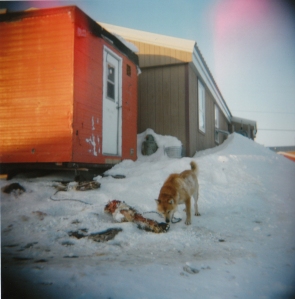How to Skin a Polar Bear
October 16, 2010
While I was in Baffin Island training for my Ellesmere Island Expedition we did a 300 mile race across the frozen landscape to a little village called Kimmirut. This little village is made up almost entirely of Inuit, and though they now live in modern homes, much of the rest of their lives is still very traditional. Hunting, surviving on the ice, and dogsledding take up a good portion of their time. The hunting they do provides them with their meat, much of their clothing, and with a sense of tradition that may be impossible for someone like me to understand though I really do try. It was found out that I’d done a lot of work involving sharks, and one of the students in the local school was doing a project on sharks, so I was asked to come in and speak to the class. To my surprise, upon entering the classroom, they were in the midst of skinning a polar bear. My conservation oriented mind was horrified, but as it is often necessary to do, I put my personal feelings aside and tried to see things from their perspective. 
In some villages, foreigners will come in and purchase the rights to shoot a polar bear for up to $60,000. The inuit are allowed to take so many bears a year for their needs, and sadly, many of them are now more in need of cash than fur and meat. Kimmirut was not one of these villages, they had the bear for their own purposes.
Later on in the expedition, I was in another town further north, and their economy had become largely dependant on foreigners coming in to hunt bears. This town was much richer than Kimmirut, and had little need for the bears who’s lives they sold. Walking down the street you would see dogs sitting there tied up, chewing on a frozen polar bear leg. At some point I’d like to get back there to do this story, but in all my efforts, I’ve been turned away from the village where I saw this. Perhaps I’ll have to go under the guise of a “hunter photographer.”
People, if you want to hunt a polar bear, I challenge you to even the odds. Walk out there onto the ice, survive off of what you can find in the frozen landscape, and at least use a knife instead of a long range rifle.
The furs rarely leave the village anyway because it’s illegal to take the fur across the border from Canada, so all the foreign hunters get in the end is a photograph with them a the dead bear.
Better yet, challenge yourself to take a good photo of a living bear, it’s harder than killing it, and the bear gets to walk away.